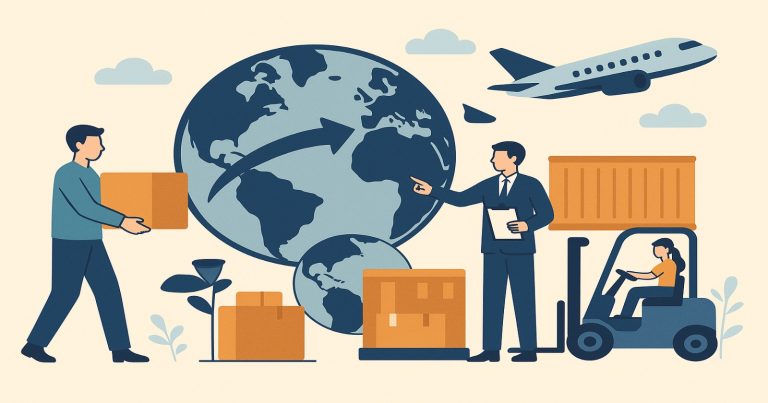Import trade means bringing goods and services into one country from another. When a country buys things like machines, oil, or clothes from another country, it is doing import trade. This is a very important part of international trade. Every country needs goods that it cannot make itself or cannot produce in large amounts. So, it buys them from other countries. This buying of goods from outside the country is called import trade. Import trade helps a country meet the needs of its people and businesses. It also brings in better quality goods, advanced technology, and new products. For example, India imports crude oil, gold, electronics, and medicines from other countries. These items are used in our daily life and in big industries. Without import trade, a country may face shortages or pay very high prices for some goods.
What is Import Trade?
Import trade refers to the buying and bringing goods and services from a foreign country into one’s own country to sell them domestically. This trade involves international transactions where goods flow from one country to another. Importing is a vital part of the global economy as it enables countries to access products they do not produce locally or cannot produce efficiently. Import trade plays a crucial role in enhancing the availability of products, promoting competition, and providing consumers with diverse options. It involves various processes and requires an understanding of international trade policies, tariffs, and regulations.
Key Objectives of Import Trade
Import trade plays a significant role in any economy, and understanding its key objectives is essential. The primary goal of import trade is to fulfill domestic demand for goods and services that cannot be produced locally, either due to lack of resources, technology, or other reasons.
Economic Growth and Development
The main objective of import trade is to stimulate economic growth and development. By importing goods and services from other countries, businesses can access raw materials, machinery, and technology they need to operate efficiently. This contributes to the growth of industries, which in turn leads to job creation, increased productivity, and improved living standards. Importing high-quality goods at competitive prices can also drive innovation, as local businesses can access better resources to develop their own products.
Diversification of Products
Countries often import goods to diversify the range of products available to consumers. This offers variety, providing consumers with more options in terms of quality, design, price, and features. Import trade allows people to access products that are not locally available or that are produced in insufficient quantities. It also encourages competition, which can lower prices and improve the overall quality of goods and services available in the market.
Access to Technology and Expertise
Through import trade, countries can gain access to advanced technologies, production methods, and management expertise. This access helps improve the efficiency of domestic industries and promotes technological innovation. For instance, importing machinery, electronics, and software from other countries can help boost domestic manufacturing capabilities and infrastructure.
Filling Domestic Gaps in Supply
Another key objective of import trade is to fill gaps in the domestic supply of certain products. Many countries rely on imports to meet the needs of industries or consumers. For example, if a country lacks the natural resources or climate necessary to produce certain crops or materials, importing them ensures that there is no shortage in the market. Import trade helps stabilize the supply of goods and services, ensuring that consumer demand is met without disruption.
Promoting International Relations
Import trade helps build strong international relationships between countries. Trade agreements, such as free trade agreements (FTAs), encourage countries to engage in the exchange of goods and services, fostering diplomatic and economic ties. This cooperation promotes peace, collaboration, and mutual benefits for trading nations.
Job Creation and Employment
Import trade can contribute to job creation. While it involves the inflow of goods from abroad, it also creates employment opportunities in the logistics, shipping, warehousing, customs, and retail sectors. As demand for imported goods increases, businesses require more workers to handle and distribute these products, boosting employment rates in various industries.
Steps Involved in an Import Transaction
Understanding the steps involved in an import transaction is crucial for businesses and individuals involved in import trade. These steps ensure that the transaction is completed successfully, following all necessary legal, financial, and logistical procedures.
Step 1: Identifying the Product and Supplier
The first step in an import transaction is identifying the product that needs to be imported. Businesses must determine the type of goods they require and research reliable suppliers from foreign countries. It’s important to evaluate the supplier’s reputation, quality standards, and reliability before proceeding with an order.
Once a supplier is chosen, businesses enter into negotiations for the terms and conditions of the sale, including price, quantity, and delivery terms.
Step 2: Understanding Import Regulations and Tariffs
Before importing goods, businesses must understand the import regulations and tariffs imposed by the importing country. Each country has different laws regarding imports, including duties, taxes, and specific product regulations. Companies need to comply with these regulations to avoid fines, delays, or issues at customs. Importers should be aware of any product-specific requirements, such as labeling, packaging, or certification standards.
Step 3: Arranging for Payment
After finalizing the supplier and understanding the regulations, the next step is arranging payment. Payment methods in international trade often include bank transfers, letters of credit, or open account arrangements. It’s important to choose a payment method that offers security and minimizes financial risk for both parties.
Step 4: Shipping and Transportation
The next step is arranging the shipment and transportation of the goods. This includes selecting the mode of transport (air, sea, or land) and securing necessary documentation like a bill of lading, packing list, and commercial invoice. Transportation can be done through freight forwarding companies that specialize in international shipments. Timely and efficient shipping is crucial to avoid delays and minimize additional costs.
Step 5: Customs Clearance
Once the goods arrive at the port of entry, they must clear customs before they can be distributed. Customs authorities inspect the goods to ensure they comply with import regulations. The customs process involves submitting required documents, paying any import duties or taxes, and verifying that the goods meet safety and quality standards.
Step 6: Receiving the Goods
After customs clearance, the goods are released for delivery to the importer. They are either picked up from the port or delivered to the importer’s location. The final step involves inspecting the goods to ensure they meet the agreed-upon specifications and quality standards.
Top Factors Affecting Import Trade
Several factors influence the success and volume of import trade. These factors can range from economic conditions and government policies to technological advancements and geopolitical events. Understanding these factors helps businesses and policymakers make informed decisions regarding imports.
Economic Conditions
Economic conditions in both the importing and exporting countries play a significant role in import trade. A strong economy typically leads to increased demand for imported goods, as consumers have more disposable income to spend on foreign products. Conversely, a downturn in the economy can reduce demand for imports, as consumers and businesses focus on local products or reduce overall consumption.
Exchange Rates
Exchange rates directly affect the cost of importing goods. If the currency of the importing country weakens against the currency of the exporting country, the cost of imports increases. Fluctuations in exchange rates can create instability and unpredictability in import trade, which is why businesses often use hedging techniques to manage this risk.
Trade Policies and Tariffs
Government policies, including tariffs, quotas, and trade agreements, have a major impact on import trade. Tariffs increase the cost of imported goods, making them less attractive to consumers. Conversely, free trade agreements (FTAs) and reduced tariffs can encourage imports, allowing businesses to access cheaper goods and services.
Technological Advancements
Advancements in technology, such as improved transportation methods and logistics, have made international trade more efficient. With faster shipping methods and better tracking systems, goods can move across borders more quickly, reducing the time and cost associated with imports.
Geopolitical Events
Geopolitical events, such as trade wars, sanctions, or conflicts, can disrupt import trade by affecting the availability of goods or increasing the cost of transportation. Political instability can also impact trade routes, making it harder for goods to reach their destination.
Import Trade FAQs
What are the types of goods imported in trade?
Import trade involves various goods, including raw materials, machinery, electronics, food products, and consumer goods. These goods are brought in from other countries to meet local demand or fill gaps in domestic supply.
Why do countries engage in import trade?
Countries engage in import trade to access products and resources that are not available locally, such as advanced technology, raw materials, and unique consumer goods. Imports help fulfill domestic demand and contribute to economic growth.
What are tariffs and how do they affect import trade?
Tariffs are taxes imposed on imported goods, which increase the cost of those goods. High tariffs can reduce the volume of imports, while low tariffs encourage more imports. Governments use tariffs to regulate trade and protect domestic industries.
How do exchange rates affect import trade?
Exchange rates affect the price of imports. When the value of the domestic currency decreases, the cost of importing goods increases. Conversely, a stronger domestic currency makes imports cheaper for consumers and businesses.
How can a business minimize risks in import trade?
To minimize risks in import trade, businesses can secure trade insurance, work with reliable suppliers, and stay informed about changes in tariffs, exchange rates, and trade policies. They can also use hedging strategies to manage currency risk.


